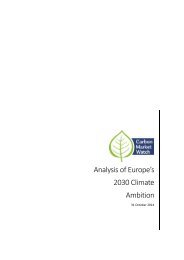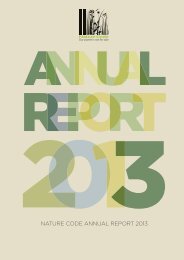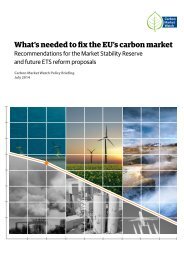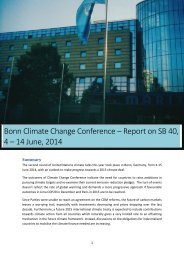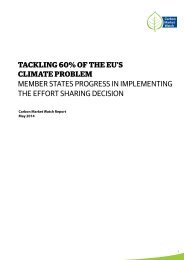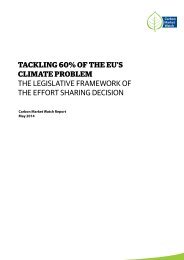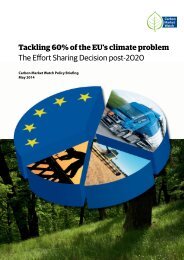THE ROLE OF INTERNATIONAL OFFSETS IN THE FUEL QUALITY DIRECTIVE
Create successful ePaper yourself
Turn your PDF publications into a flip-book with our unique Google optimized e-Paper software.
Alberta Offset System<br />
Alberta’s offset credit system is a compliance mechanism for entities<br />
regulated under the province’s mandatory GHG emission intensitybased<br />
regulatory system. Large final emitters 9 are required to<br />
reduce their GHG intensity by up to 12% per year 10 , as part of the<br />
2002 Climate Change and Emissions Management Act (CCEMA) and<br />
the 2007 Specified Gas Emitters Regulation passed by the Alberta<br />
legislature 11 . The following approved quantification protocols exist<br />
and would be eligible for use under the FQD 12 :<br />
- Engine Fuel Management and Vent Gas Capture Projects:<br />
GHG reductions from the improvement in the fuel efficiency<br />
of natural gas combustion engines and the capture of gases<br />
(primarily methane) normally vented to the atmosphere,<br />
including in upstream oil and gas operations.<br />
- Enhanced Oil Recovery: GHG reductions created by the<br />
capture, processing, transport injection, recirculation<br />
and geological storage of waste gases from oil and gas<br />
production processes or other industrial processes.<br />
- Enhanced Oil Recovery (streamlined): GHG reductions<br />
created by the capture, processing, transport, injection,<br />
recirculation and geological storage of waste gases from oil<br />
and gas production processes.<br />
- Substitution of Bitumen Binder in Hot Mix Asphalt<br />
Production and Usage: GHG reductions from substitution<br />
of a proportion of the bitumen binder used in conventional<br />
hot mix asphalt for a sulphur product.<br />
Given that reductions have to occur “prior to the raw material<br />
entering a refinery or processing plant” also GHG reductions from<br />
road construction could be eligible under the current Commission’s<br />
scope. Under the Alberta Offset Systems, two projects have been<br />
registered after the cut-off date 1 January 2011, that fall within the<br />
scope of the proposed project type scope:<br />
- Shell Thiopave 2012 Oil Sands Region Paving Project<br />
(Project Identifier: 1663-1877) 13<br />
- Bonnyville Road Paving Project Using Shell Thiopave<br />
(Project Identifier: 6438-8753) 14<br />
Both projects claim 300.000 and 343.000 tonnes CO 2<br />
savings<br />
respectively for activities that occurred as part of the construction<br />
of road sections in Alberta - specifically, a section of the Shellowned<br />
Canterra road which connects Highway 63 to the Shell oil<br />
sands mining activities north of Ft McMurray, and 16 km of Highway<br />
659, east of the town of Bonnyville, a town situated in east-central<br />
Alberta between the City of Cold Lake and the Town of St. Paul.<br />
Examples of possible offsets from tar sands operations<br />
Examples of possible offsets from tar sands operations<br />
The Fuel Quality Directive has been subject to fierce debate around separate default values for unconventional oils like tar sand<br />
oils. Few people are however aware that offset credits generated from tar sand operations could potentially be used as upstream<br />
emission reductions.<br />
The credits from projects registered under the Alberta offset system could in the absence of further restrictions also be eligible to<br />
count towards the FQD’s decarbonisation target. As mentioned in the previous section, two projects have already been registered<br />
under the Alberta Offset System after 2011. These projects claim a total of ~600.000 tonnes CO 2<br />
savings for activities that occurred<br />
as part of the construction of road sections in Alberta, connecting the Shell oil sands mining activities to the highway and harbor.<br />
Another project registered under the Alberta Offset System is a project by Genalta power of Alberta converting waste gas (a<br />
byproduct of bitumen extraction in oil sands that is typically flared), into electricity, earning 8,208 tonnes of carbon offsets credits<br />
in the year 2013.<br />
Other potential projects that could be registered under the Alberta Offset System in the future, and potentially be eligible for use<br />
under the Fuel Quality Directive, include:<br />
• The Quest Carbon Capture and Storage (CCS) project that reduces CO 2<br />
emissions from tar sand operations. From late<br />
2015, Quest will capture and store underground more than 1 million tonnes of CO 2<br />
per year, according to Shell. The<br />
Quest project will be built on behalf of the Atabasca Oil Sands Project joint venture owners Shell, Shevron and Marathon<br />
Oil with support from the Governments of Canada and Alberta.<br />
• The Alberta Carbon Trunk Line CCS project that captures CO 2<br />
from oil sand operations and stores it in depleted oil<br />
and gas fields for Enhanced Oil Recovery. Initially, the system will capture and store up to 1.6 million tonnes of CO 2<br />
per year. The Alberta Carbon Trunk Line is expected to start operations in 2015 and has also received support from the<br />
Governments of Canada and Alberta<br />
Clean Development Mechanism<br />
The Clean Development Mechanism (CDM) is a project-based offset<br />
mechanism under the Kyoto Protocol that allows the crediting<br />
of emission reductions from greenhouse gas (GHG) abatement<br />
projects in developing countries. The CDM has two purposes:<br />
it should assist developing countries to achieve sustainable<br />
development and help industrialised countries to reduce the<br />
costs of greenhouse gas abatement. Companies and governments<br />
in Annex 1 countries can buy emission reduction credits, called<br />
Certified Emissions Reductions (CERs), from CDM projects instead<br />
of reducing their own emissions. As of October 2014, more than<br />
8.000 projects have been registered and almost 1.5 billion carbon<br />
offsets have been generated.<br />
Eligible approved emission calculation methodologies include:<br />
6




